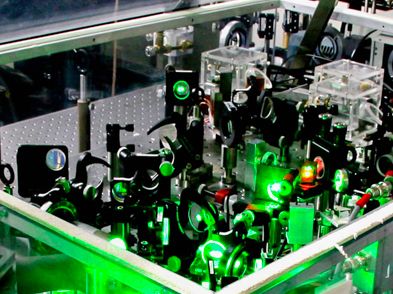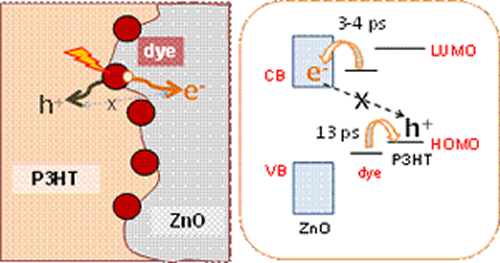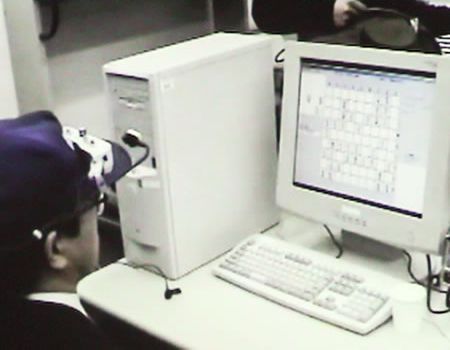Topics - e-Bulletin
University of Electro-Communications publishes June 2014 issue of e-Bulletin

The June 2014 issue of the University of Electro-Communications e-Bulletin describes the latest news, events, and research from one of Japan's science and technology based research universities with approximately 4,000 students and 350 faculty, with expertise in wireless communications, laser science, robotics, informatics, and material science:
Feature
Frontiers of optical science: Ultrashort pulses of light produced by Raman scattering from hydrogen for next generation laser optical communications
Masayuki Katsuragawa describes his research on the manipulation of light-matter interaction for producing ultra-short pulses of laser light. "Our recent experiments on adiabatic stimulated Raman scattering in parahydrogen show potential for the realization of laser light sources producing pulses at terahertz repetition-rate frequencies. These ultra-short pulses offer a new 'axis' in the evolution of laser based optical science."
Research Highlights
Control systems: Fuzzy features
http://www.ru.uec.ac.jp/e-bulletin/research-highlights/2014/fuzzy-features.html
The natural world is not always logical, and precise states such as 'true' or 'false' are quite rare. The field of fuzzy logic takes account of this fact by creating models in which truth is represented on a continuous scale between 0 and 1. Mathematical control systems based on fuzzy logic have proved useful for real-world situations such as handwriting recognition on pocket computers, auto-focusing on cameras, and earthquake prediction.
One popular fuzzy control methodology is the Takagi-Sugeno (T-S) model, which involves interactions between 'controllers' and 'observers' represented by matrix polynomials. Now, Kazuo Tanaka and colleagues at the University of Electro-Communications in Tokyo, with co-workers at Kyushu Institute of Technology and Boston University, USA, have used a sum-of-squares approach to design effective observers within three classes of T-S fuzzy systems1.
Optical signal processing: Neater networks
http://www.ru.uec.ac.jp/e-bulletin/research-highlights/2014/neater-networks.html
The demand for fast access to data through optical networks requires technology that can handle ever more complex and high-bandwidth signals. However, the signal processing usually requires conversions from optical to electronic and back again, which can be power-hungry and expensive.
To move towards cheaper, more environmentally-friendly photonics, researchers are working on optical signal processing devices that require no signal conversions. A central aim for such devices is 'wavelength division multiplexing' (WDM), whereby one device can operate on many signals at the same time, if each signal has a different wavelength.
Now, Hung Nguyen Tan, Motoharu Matsuura and Naoto Kishi at the University of Electro-Communications in Tokyo have built an optical switching device that not only performs WDM, but also processes signals with different data formats, and convert signals between formats.
Pharmacophores: The future of drug discovery
http://www.ru.uec.ac.jp/e-bulletin/research-highlights/2014/the-future-of-drug-discovery.html
Developing new drugs that bind exclusively to target cells in diseases such as cancer is crucial. Masumi Taki and co-workers at the University of Electro-Communications in Tokyo, together with scientists at Kagoshima University, Japan, have expanded on current drug discovery methods to create a hybrid-drug generating system for this purpose.
Their system uses 'artificial-molecule evolution'- taking non-natural core molecules and adapting and optimizing them to make new 'pharmacophores'. A pharmacophore is a molecular model which can be manipulated to bind molecules for targets such as cancer cells.
Hybrid solar cells: The Mechanism of dyeing for greater efficiency

Light-harvesting organic materials have the potential to provide low cost electricity through solar power. However, current designs for organic-inorganic hybrid solar cells (OIHSCs) suffer weaknesses at the interface between organic and inorganic components and this limits efficiency.
Now, Qing Shen at the University of Electro-Communications, Tokyo, and Shuzi Hayase at Kyushu Institute of Technology together with scientists in Hayase JST CREST Research Team across Japan, have succeeded in clarifying the mechanism for improving the performance of an OIHSC by adding a dye sensitizer directly onto the organic-inorganic interface.
News and Events
Tokyo Wireless Technology Summit 2014
http://www.ru.uec.ac.jp/e-bulletin/news/2014/tokyo-wireless-technology-summit-2014.html
The international symposium on fifth generation (5G) cellular communications systems--Tokyo Wireless Technology Summit 2014--was held by the Advanced Wireless Communications Research Center (AWCC) in collaboration with the Global Information and Telecommunications Institute (GITI) of Waseda University, at the Masaru Ibuka Auditorium at Waseda University, Tokyo, on 7 March 2014. Beyond our expectation, more than 200 people from industry and academia participated in the symposium and thoroughly enjoyed the talks by the talented speakers.
UEC joins forces with universities in Fukushima and Iwate to study disasters
Research Station of Disaster Science on Mega Risk Management (DSMRM) at University of Electro-Communications (UEC); Fukushima Future Center for Regional Revitalization (FURE) at Fukushima University; and Research Center for Regional Disaster Management (RCRDM) at Iwate University.
Topics
Checkmate or should we say 'tsumi': The role of shogi in research on artificial intelligence and cognitive science

UEC researchers shed light on effective methods to 'teach' computers to play board games and conversely, how humans process information when playing these games.
Letter from Alumni
http://www.ru.uec.ac.jp/e-bulletin/topics/2014/letter-from-alumni-2.html
Kosin Chamnongthai, professor of Electronic and Telecommunication Engineering Department, Faculty of Engineering, King Mongkut's University of Tehcnology Thonburi, Bangkok, Thailand.
Further information
International Public Relations
The University of Electro-Communications
1-5-1 Chofugaoka, Chofu, Tokyo 182-8585
- E-mail :

- Website :
- http://www.uec.ac.jp/eng/
About The University of Electro-Communications
The University of Electro-Communications (UEC) in Tokyo is a small, luminous university at the forefront of applied sciences, engineering, and technology research. Its roots go back to the Technical Institute for Wireless Commutations, which was established in 1918 by the Wireless Association to train so-called wireless engineers in maritime communications in response to the Titanic disaster in 1912. In 1949, the UEC was established as a national university by the Japanese Ministry of Education, and moved in 1957 from Meguro to its current Chofu campus Tokyo.
With approximately 4,000 students and 350 faculty, UEC is regarded as a small university, but with particular expertise in wireless communications, laser science, robotics, informatics, and material science, to name just a few areas of research.
The UEC was selected for the Ministry of Education, Culture, Sports, Science and Technology (MEXT) Program for Promoting the Enhancement of Research Universities as a result of its strengths in three main areas: optics and photonics research, where we are number one for the number of joint publications with foreign researchers; wireless communications, which reflects our roots; and materials-based research, particularly on fuel cells.
- Website :
- http://www.uec.ac.jp/eng/

